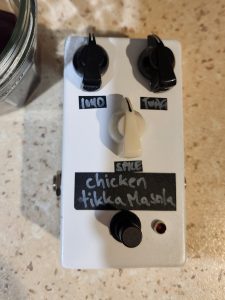 Hopefully this article is going to be short and sweet, as the concept of volume knobs in guitar pedals (and guitars for that matter) is quite simple. This explanation should hold for volume control on analogue devices, however, I’m not sure if it holds for digital volume control; it probably does in a general sense, but digital stuff is controlled in such a different way to analogue stuff, I’m not going to say that’s the case. I’m an analogue guy and, while I know a bit about digital subjects, my knowledge is limited there.
Hopefully this article is going to be short and sweet, as the concept of volume knobs in guitar pedals (and guitars for that matter) is quite simple. This explanation should hold for volume control on analogue devices, however, I’m not sure if it holds for digital volume control; it probably does in a general sense, but digital stuff is controlled in such a different way to analogue stuff, I’m not going to say that’s the case. I’m an analogue guy and, while I know a bit about digital subjects, my knowledge is limited there.
All that being said, if you’re wondering how the volume knob on a guitar pedal or guitar works, you’re in the right place. If you’re wondering how volume control for stereos, televisions, etc., you might be in the right place (so stick around).
Volume Is A Function Of Resistance
An analogue sound signal, which is the signal that electric guitars produce and (analogue) effects pedals manipulate is just a simple electrical wave in the form of alternating current. A signal is generated by the electric guitar, it moves through a cable, into a pedal, the pedal does its magic, and you get cool sounds. If you want a deeper explanation of this, check out my article on how guitar pedals work.
Through this process, you can control the volume on your electric guitar or on the pedal itself.
Since it’s just an electrical signal, and the voltage of that signal controls the volume, increasing the resistance that that electrical signal goes through will cause a voltage drop and therefore make the volume lower.
That’s basically the whole process! Increase the resistance on the electrical signal and the volume goes down, decrease it and the volume goes up (kind of).
I say kind of because, with passive volume control like this, you’re not actually turning “up” the volume, you’re just not lowering. When it hits the volume control, the electrical signal from the guitar has as high a voltage as it’s going to have, you can’t increase this voltage and therefore increase the volume, all you can do is increase the resistance and therefore decrease the volume. Of course I’m ignoring anything that happens before the volume that may amplify the signal (i.e. increase the voltage). This may happen with an operational amplifier, a transistor, or even a vacuum tube..
How Is The Resistance Adjusted?
Firstly, if you’re unfamiliar with resistance and how it affect voltage, take a look at my article on Ohm’s Law as well as my guide to resistors in guitar pedals. But resistance is pretty much what it sounds like: how much opposition there is to the current. Make it harder for the current to move through, and the voltage will drop (see Ohm’s Law above).
You can adjust the resistance by simply adding a resistor, but that’s a bit static. With a resistor you’ll just get a set volume and that’s not very fun.
And this is what potentiometers are for. A potentiometer is just a variable resistor and that’s what the knob on your guitar or effects pedal is attached to. A potentiometer has three pins, with the middle pin being a wiper that moves back and forth adjusting the resistance between the two outer pins. Inside a potentiometer looks like this:
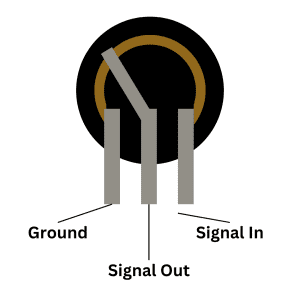
So, turned all the way to the left, there’s less resistance between the left pin and middle pin, and lots of resistance between the right pin and the middle pin. Turn it all the way to the right and you have the opposite.
So, if you wire a potentiometer for the signal to come in via the the right pin and go out through the middle pin (with the left pin going to ground), you get less resistance when the potentiometer is turned clockwise, letting more voltage (and therefore volume) through. Turn the potentiometer counterclockwise, and you get more resistance, letter less resistance through. I have more on this in my guide to wiring potentiometers.
What If You Want To Turn Up The Volume?
As mentioned, with a passive volume adjustment like this, you can’t add more volume, you can only take it away by adding resistance to the circuit. You’re not really turning up the volume, you’re just not turning it down.
If, even with little to no resistance, you’re getting no volume coming through, there’s obviously a problem. If this is a guitar pedal that you’re building, it’s probably time to debug your guitar pedal build. As mentioned, volume is a function of the resistance in the circuit, and if there’s a short circuit somewhere or something is touching something it’s not supposed to, resistance may be added to the circuit somewhere it’s not supposed to, lowering the volume of the pedal. I had trouble with this when building my Purple Plexi pedal.
If you’re trying to design or modify a circuit and you want it louder, achieving this will depend on the circuit itself. With most guitar pedals, an op-amp or transistor is used to amplify the signal and sometimes even distort the sound. How much and how the signal is amplified will depend on the gain of the op-amp/transistor and its saturation point, but that’s a whole other article. But, to answer a question you haven’t asked, this is basically how a solid state amplifier works as well!
So, assuming there’s no problem with how you’ve built the pedal, if you’re looking for more volume, you need to look at the amplification stage of the pedal. Perhaps you need a different component to better amplify the signal or you need to modify the resistance in this part of the circuit to create more gain.
Related posts:
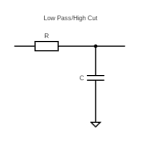 How High Pass And Low Pass Filters Work In Guitar Pedals
How High Pass And Low Pass Filters Work In Guitar Pedals
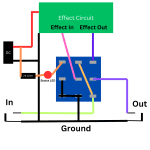 How To Wire A Guitar Pedal Foot Switch (3PDT)
How To Wire A Guitar Pedal Foot Switch (3PDT)
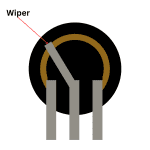 Potentiometer Wiring: How To Wire A Potentiometer
Potentiometer Wiring: How To Wire A Potentiometer
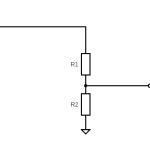 What Is A Voltage Divider?
What Is A Voltage Divider?
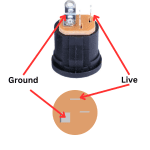 How To Wire A Guitar Pedal DC Power Jack
How To Wire A Guitar Pedal DC Power Jack
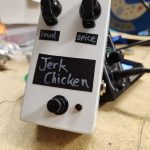 Why You Should Build Your Own Guitar Pedals
Why You Should Build Your Own Guitar Pedals
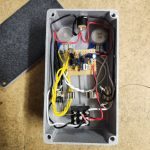 How To Wire Guitar Pedal Enclosures
How To Wire Guitar Pedal Enclosures
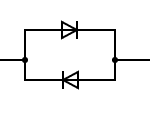 What’s The Difference Between Symmetrical And Asymmetrical Clipping?
What’s The Difference Between Symmetrical And Asymmetrical Clipping?
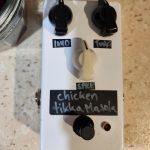 Is It Expensive To Make Your Own Guitar Pedals?
Is It Expensive To Make Your Own Guitar Pedals?
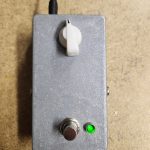 A Versus B Potentiometers (And When To Use Them)
A Versus B Potentiometers (And When To Use Them)

